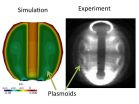(Press-News.org) Researchers at the U.S. Department of Energy's Princeton Plasma Physics Laboratory (PPPL) have for the first time simulated the formation of structures called "plasmoids" during Coaxial Helicity Injection (CHI), a process that could simplify the design of fusion facilities known as tokamaks. The findings, reported in the journal Physical Review Letters, involve the formation of plasmoids in the hot, charged plasma gas that fuels fusion reactions. These round structures carry current that could eliminate the need for solenoids - large magnetic coils that wind down the center of today's tokamaks - to initiate the plasma and complete the magnetic field that confines the hot gas.
"Understanding this behavior will help us produce plasmas that undergo fusion reactions indefinitely," said Fatima Ebrahimi, a physicist at both Princeton University and PPPL, and the paper's lead author.
Ebrahimi ran a computer simulation that modeled the behavior of plasma and the formation of plasmoids in three dimensions thoughout a tokamak's vacuum vessel. This marked the first time researchers had modeled plasmoids in conditions that closely mimicked those within an actual tokamak. All previous simulations had modeled only a thin slice of the plasma - a simplified picture that could fail to capture the full range of plasma behavior.
Researchers validated their model by comparing it with fast-camera images of plasma behavior inside the National Spherical Torus Experiment (NSTX), PPPL's major fusion facility. These images also showed plasmoid-like structures, confirming the simulation and giving the research breakthrough significance, since it revealed the existence of plasmoids in an environment in which they had never been seen before. "These findings are in a whole different league from previous ones," said Roger Raman, leader for the Coaxial Helicity Injection Research program on NSTX and a coauthor of the paper.
The findings may provide theoretical support for the design of a new kind of tokamak with no need for a large solenoid to complete the magnetic field. Solenoids create magnetic fields when electric current courses through them in relatively short pulses. Today's conventional tokamaks, which are shaped like a donut, and spherical tokamaks, which are shaped like a cored apple, both employ solenoids. But future tokamaks will need to operate in a constant or steady state for weeks or months at a time. Moreover, the space in which the solenoid fits - the hole in the middle of the doughnut-shaped tokamak - is relatively small and limits the size and strength of the solenoid.
A clear understanding of plasmoid formation could thus lead to a more efficient method of creating and maintaining a plasma through transient Coaxial Helicity Injection. This method, originally developed at the University of Washington, could dispense with a solenoid entirely and would work like this:
Researchers first inject open magnetic field lines into the vessel from the bottom of the vacuum chamber. As researchers drive electric current along those magnetic lines, the lines snap closed and form the plasmoids, much like soap bubbles being blown out of a sheet of soapy film.
The many plasmoids would then merge to form one giant plasmoid that could fill the vacuum chamber.
The magnetic field within this giant plasmoid would induce a current in the plasma to keep the gas tightly in place. "In principle, CHI could fundamentally change how tokamaks are built in the future," says Raman.
Understanding how the magnetic lines in plasmoids snap closed could also help solar physicists decode the workings of the sun. Huge magnetic lines regularly loop off the surface of the star, bringing the sun's hot plasma with them. These lines sometimes snap together to form a plasmoid-like mass that can interfere with communications satellites when it collides with the magnetic field that surrounds the Earth.
While Ebrahimi's findings are promising, she stresses that much more is to come. PPPL's National Spherical Torus Experiment-Upgrade (NSTX-U) will provide a more powerful platform for studying plasmoids when it begins operating this year, making Ebrahimi's research "only the beginning of even more exciting work that will be done on PPPL equipment," she said.
INFORMATION:
PPPL, on Princeton University's Forrestal Campus in Plainsboro, N.J., is devoted to creating new knowledge about the physics of plasmas -- ultra-hot, charged gases -- and to developing practical solutions for the creation of fusion energy. Results of PPPL research have ranged from a portable nuclear materials detector for anti-terrorist use to universally employed computer codes for analyzing and predicting the outcome of fusion experiments. The Laboratory is managed by the University for the U.S. Department of Energy's Office of Science, which is the largest single supporter of basic research in the physical sciences in the United States, and is working to address some of the most pressing challenges of our time. For more information, please visit science.energy.gov.
There is a wealth of published information describing interactions between drugs used to treat cardiovascular disease and the genetic variations that can affect how patients respond to them. But few heart specialists make routine use of this potentially life-saving data.
To help physicians make better-informed clinical decisions, researchers from the University of Chicago and Stanford University combed through scientific literature on the pharmacogenomics of 71 leading cardiovascular drugs and compiled summaries, published in the June issue of the Mayo Clinic Proceedings.
"Tens ...
Academic programs that provide alternatives to traditional remedial education help students succeed at community colleges, but different programs result in a range of outcomes for various sub-populations of students. Drew Allen, a New York University doctoral student and director of the Office of Research, Evaluation, and Program Support at the City University of New York (CUNY), devoted his doctoral research to the evaluation of three current programmatic approaches at CUNY community colleges.
Entering community college students are often required to take remedial, ...
Some female members of a critically endangered species of sawfish are reproducing in the wild without sex. The discovery, reported in the Cell Press journal Current Biology on June 1, marks the first time living offspring from "virgin births" have been found in a normally sexually reproducing vertebrate in the wild, the researchers say.
Earlier evidence that vertebrates might sometimes reproduce via a process called parthenogenesis had primarily come from isolated examples of captive animals--including birds, reptiles, and sharks. In those instances, the animals in question ...
Despite guideline recommendations to limit medical tests before low-risk surgeries, electrocardiograms (ECGs) and chest x-rays are still performed frequently, found a study in CMAJ (Canadian Medical Association Journal).
Evidence indicates that for patients undergoing low-risk surgery, routine testing does not improve outcomes and can actually lead to surgical delays, patient anxiety and other issues. The Choosing Wisely campaign, which started in the United States and spread to Canada and other countries, aims to raise awareness of unnecessary tests and procedures among ...
Radon gas is a silent health threat, and Canada needs to align its guidelines for acceptable radon levels with World Health Organization (WHO) limits, argues an editorial in CMAJ (Canadian Medical Association Journal).
"We are left in an odd situation in Canada," writes Dr. Diane Kelsall, Deputy Editor, CMAJ. "Drivers and passengers are required to wear seat belts, which are estimated to save about 1000 lives per year. Smoke alarms are required in most jurisdictions, reducing the annual rate of fire-related deaths from 130 per million households by about two-thirds. Yet, ...
ROSEMONT, Ill.--Woman in general have a higher incidence of osteoporosis-related hip fractures yet, conversely, they have a lower rate of mortality than men with the same fracture, according to a study in the June 2015 issue of the Journal of the American Academy of Orthopaedic Surgeons (JAAOS). In addition, doctors don't always recognize or treat osteoporosis in men as often as they do in women.
"Male and Female Differences Matter in Musculoskeletal Disease" details the differences between how common musculoskeletal disorders manifest themselves in males versus females. ...
ROCHESTER, Minn. -- Why are major surgical errors called "never events?" Because they shouldn't happen -- but do. Mayo Clinic researchers identified 69 never events among 1.5 million invasive procedures performed over five years and detailed why each occurred. Using a system created to investigate military plane crashes, they coded the human behaviors involved to identify any environmental, organizational, job and individual characteristics that led to the never events. Their discovery: 628 human factors contributed to the errors overall, roughly four to nine per event. ...
New research on kidney stone formation reveals that zinc levels may contribute to kidney stone formation, a common urinary condition that can cause excruciating pain. The research found that zinc may be the core by which stone formation starts.
The study, led by UC San Francisco, opens a new perspective into the cause of urinary stones and related diseases and might ultimately lead to the identification of new preventive and therapeutic approaches.
The article appears in the scientific journal PLOS ONE.
"The ultimate goal of our research team is to prevent kidney ...
TORONTO, ON [1 June 2015] - By observing galaxies billions of light-years away, a team of astronomers has detected tube-like structures mere hundreds of kilometres above the Earth's surface.
"For over 60 years, scientists believed these structures existed but by imaging them for the first time, we've provided visual evidence that they are really there," said Cleo Loi of the ARC Centre of Excellence for All-sky Astrophysics (CAASTRO) at the University of Sydney and lead author of a paper published in Geophysical Research Letters last week.
The astronomers--including ...
Breastfeeding for six months or longer was associated with a lower risk of childhood leukemia compared with children who were never breastfed or who were breastfed for a shorter time, according to an article published online by JAMA Pediatrics.
Leukemia is the most common childhood cancer and accounts for about 30 percent of all childhood cancers. Still, little is known about its cause. Breast milk is meant to exclusively supply all the nutritional needs of infants and current recommendations include exclusively breastfeeding for the first six months of life to optimize ...

